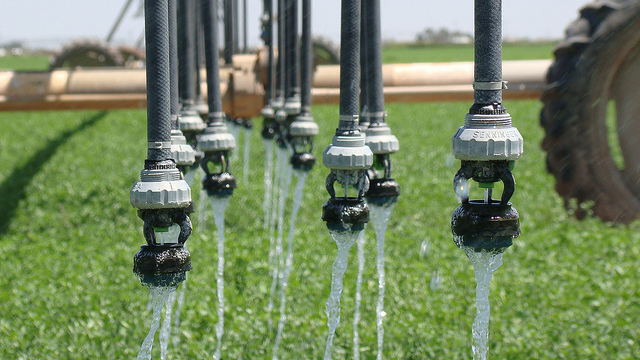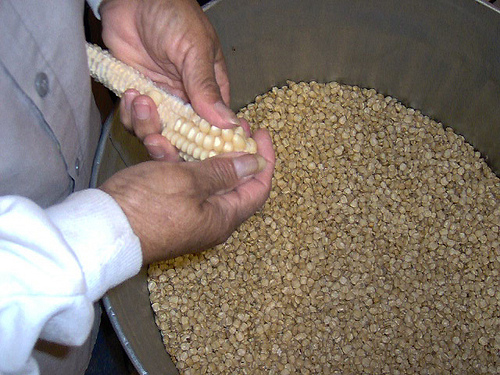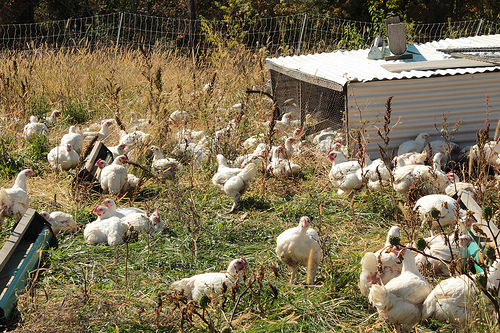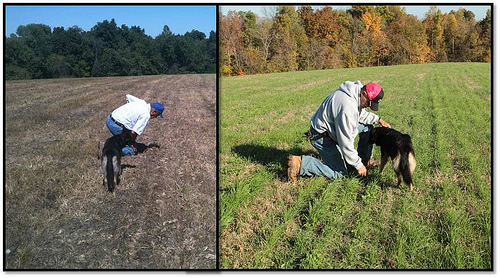
Even though he is putting his entire weight on it, Henderson’s soil pressure probe cannot penetrate the surface of the soil under his neighbor’s dryland wheat crop, which has been farmed with conventional plowing methods.
Clay County, Texas farmer Tommy Henderson may not know everything about farming, but he’s got more than the basics covered—even during a historic drought. Read more »

LESA/LEPA system on Gonzales’ alfalfa field
Joseph and Jeremy Gonzales are doing something different with their Gonzales Land and Cattle operation in Lovington, N.M., and it’s hard not to notice. Farming is hard enough without adding extra challenges. So the Gonzales brothers are using 21st-century technology to work smarter, not harder. Read more »

Scott County Indiana Muscatatuck River Bottoms, March 5-2007. Photo credit Mark Trabue.
A wetland restoration project completed by USDA’s Natural Resources Conservation Service in Kentucky has attracted the fancy of a pair of endangered whooping cranes.
In early November, a pair of whooping cranes were discovered on a property in western Kentucky that was recently restoredwith NRCS’ help. The restoration to bottomland hardwood wetlands included tree planting and the creation of shallow water areas for migratory wildlife on nearly 900 acres of former cropland that was put into a conservation easement. Read more »

A member of the Mississippi Band of Choctaw Indians removes the kernels from a corn of cob, one step in the hominy-making process.
For special meals like those on birthdays and Christmas, members of the Mississippi Band of Choctaw Indians include hominy on the menu—but hominy, essentially dried corn kernels, is expensive to purchase. Read more »

The free range meat chickens stay in their shelters to protect them from predators. Electric netting in combination with the dogs protects them. A drip line on each shelter allows for a garden hose to be connected in order to supply fresh water for the chickens in their shelter.
Over a decade ago, Winston and Teresa Pike brought their family back to the 140-acre farm where Winston grew up to begin a farming operation of their own.
Since then, the Pikes’ business has grown from a small family farm with fewer than ten pasture-fed beef cattle to a thriving operation with over 100 head of beef cattle, as well as dairy cows, hogs, meat chickens, egg laying chickens and turkeys – not to mention a variety of vegetables. The farm sells its organic products to restaurants, a co-op and online, and has a CSA (community-supported agriculture, a kind of farm subscription service). Read more »

Left: Larry Woods checking for growth a few weeks after the first field seeding this summer. Right: Larry in the same field just a few months later.
Larry Woods dedicated 36 years of his life to education in Kentucky. After a successful career as a teacher, coach and administrator, last year Larry retired to his Garrard County family farm, which he plans to develop into a full working operation for his children and grandchildren to enjoy.
Woods was raised on the 100-acre farm, and a love of farming, hunting, fishing and living off the land comes naturally for him. But when he returned to his farm, he quickly realized that keeping track of his 30 head of Charolais cattle was a next-to-impossible task. He spent countless hours rounding up the herd from ridgetop pastures and steep valleys full of tree and brush. Read more »






